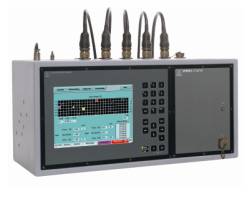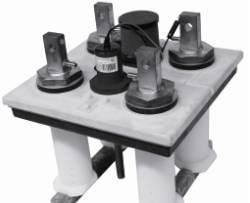New Technology for Submarine Wireless Battery Monitoring
The German navigation specialist Raytheon Anschütz introduces a newly developed wireless battery monitoring technology. The core of the system is a new sensor that features an innovative measurement concept to provide highest failure safety while contributing to cost savings during installation and servicing. Raytheon Anschütz, as a subsidiary of the Raytheon Company, presents a wireless battery monitoring demonstration at this year’s UDT in London.
The Wireless Battery Monitoring System (WBMS) is the central measuring and evaluation system for main batteries aboard submarines. It continuously and directly indicates the most important data on the condition of the batteries and consequently supplies decision aids for operational and tactical intents. The WBMS consists of a main control unit for monitoring and calculation, wireless cell sensors and wireless transceivers to transfer the data from the battery cells to the control unit.
The new wireless sensor measures voltage, acid temperature and acid level of every battery cell. Compared to conventional battery monitoring the monitoring of every battery cell raises failure safety, data availability and reliability of the whole system. Failed sensors and defective battery cells are instantaneously indicated on the control unit to provide efficient assistance in failure diagnostics.
Apart from providing data to the main control unit the sensors indicate their status on a built-in LED. Depending on the cell conditions, the LED’s indicate the performance level by lightning in one of four colors. This allows to identify critical sensors and need for servicing easily at an early stage even in narrow battery rooms on board. As a further improvement, by means of wireless technology safety-critical failures such as wire-break cannot happen.
The wireless layout of the sensors significantly reduces costs of cabling and installation time of units in the battery room for both, newbuild and refit programs. With its solid, shock-approved design the sensors feature built-in reliability even under most demanding subsea conditions. Wilfried Romming, Segment Manager for Submarine Refit Programs at Raytheon Anschütz, states: “The new technology is a step ahead towards a most reliable system that provides more insights into system performance while contributing to costs savings during installation and servicing. Backed-up with a long experience in submarine business, our wireless solutions can be adapted to almost any system requirements.”
The WBMS uses the sensor information to calculate all relevant data of the complete battery bank of the submarine such as battery power, discharged capacity and status of all battery cells. Furthermore, depending on the actual power or a several scenario based prediction of power consumption, the system is able to estimate the residual charge/discharge time and the residual capacity. Thereby, the onboard system configuration of cell sensors and transceivers can be adapted to the amount of battery cells, battery rooms and redundancy requirements.
A mixture of conventional and wireless sensors is possible, what makes the wireless technology simple to integrate into existing system. As an example, in addition to conventional monitoring the modular arrangement of wireless technology provides placing of additional wireless sensors to monitor pre-defined critical cells in greater detail to achieve higher failure safety and data availability. The modular system layout even allows single sensors to measure only selected values such as battery voltage. “With its flexible configurability the wireless sensor technology is especially suited for cost-efficient refit purposes. In existing submarines the wireless sensors can be easily installed in the battery rooms, no additional cabling is necessary to get a more detailed knowledge and increased reliability of the total battery banks.”, Mr. Romming says.
The demonstration of the new wireless battery monitoring, together with further navigation and control solutions for submarines, is part of the Raytheon exhibit at booth B15 in hall S9-S10 at UDT 2011.
Source: http://www.raytheon-anschuetz.com















